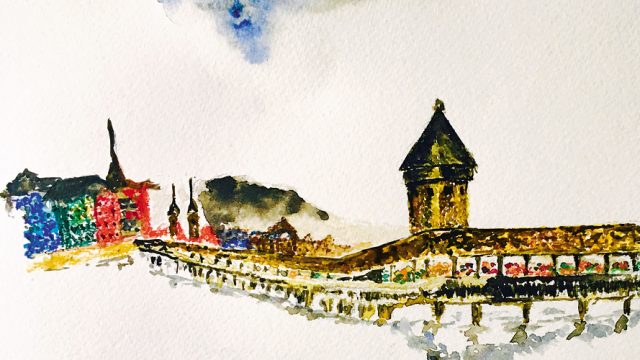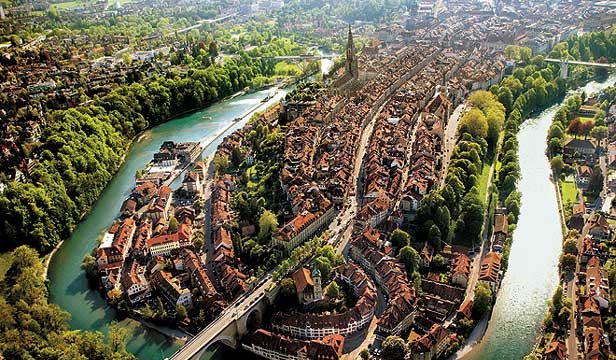Perched on a high stool in the tiny 3×6 office of Manfred Roth, the Executive Chef
The next morning, clarity restored with the help of fresh breads and jams, strong coffee and tasty juice — all served in First Class style on a crisp white tablecloth on a small table in my mammoth room with an English-language newspaper, smiles and the day’s weather forecast thrown in for good measure — I hugged myself happily on the high stool in the basement. The Hotels Editor of this magazine has realised a long-standing dream: to descend into the great belly of a grand hotel and understand the profound business of how it all works. How does a hotel of this size and vintage serve fine food at once at three restaurants, at any or all of its 212 rooms, at its spa cafeteria, by the swimming pool, on the lawns…? Who are these magicians in the basement who salt dishes just so, get temperatures just right, pander to every fussy guest’s special requests? How does it all reach tables in time? Who thought up that unpretentious but most excellent meal I’d eaten the night before — the one with ‘spicy carpaccio of beef from the Schrofen farm with quiche of asparagus from Thurgau’, the ‘roasted filet of pork with stewed chard stalks, tomato and home-made spaetzli’, the ‘Russian chocolate cheesecake with iced and fresh strawberries’?
The answer is sitting across the table from me, smiling happily and speaking with passion and delight. Manfred Roth has spent several years at the Hilton hotels in Japan, a man who loves Delhi and Bombay and exclaims at the glories of a samosa. So I take him seriously when he speaks disparagingly about ‘fusion food’, about the uselessness of mixing distinct traditional flavours. I knew what he was talking about because in another meal, in La Pastateca, the hotel’s pasta restaurant, I had ordered the unusual-sounding ‘soup of limes with deep water shrimps’. It proved to have no Italian connection at all, but an abiding, gentle Thai one. The ‘ravioli of fresh cheese with peperoncini and pepper butter’ was perfectly, faithfully Italian.
For two hours, I sat spellbound as the purist spoke of the treasures of ‘ethnic foods’, of the importance of food made fresh every day, about correcting imbalances in traditional starch-meat-based foods (Swiss), of correcting imbalances in traditional butter-and-refined-flour-based foods (French), of the wonders of regions that have strong snack food cultures (Indian), of the fashionable-again glories of the one pot that simmers on the stove for hours, of this and that… He then bounded out of his chair and led me on a grand tour of his fiefdom — the large ‘prep’ kitchen, the three ‘satellite’ kitchens that served the three restaurants, the restaurants themselves, the massive deep-freezer area, and finally with the utmost delight, to his herb garden behind the hotel.
Over my years of touring hotels, sniffing out unsung gems and critically inspecting large establishments, I’ve got in the habit of essentialising each hotel. And after my joyful encounter with Roth, the essence of this impressive pile comes bubbling up to the boil: the true luxury of a hotel such as this is that it wears its luxuriousness so lightly. It is not embarrassed to bring the esteemed guest below stairs, behind the majestic façade and beyond the elegant stage-sets of its rooms and restaurants, closer to its beating heart. In fact, at the Victoria-Jungfrau, it is quite an institution — children are offered a one-hour ‘look behind the scenes’ with a chosen member of the staff, from the director of the hotel to the concierge to the chambermaid to the gardener.
The informal and friendly style of the hotel belies its long, impressive history. The Victoria-Jungfrau began life as two adjacent, but separate hotels — the Hotel Victoria and the Hotel Jungfrau — in 1865 and 1864, respectively. In 1895, the owner of the Victoria, Eduard Ruchti, acquired the Jungfrau and in 1899 the two hotels were connected with its still-standing, distinctive dome-topped central tract.
In this picture-perfect part of the world, peopled more by visitors than local residents, it’s hard to imagine that there was ever a pre-tourist Interlaken. But there was — before the mountain railways connected the Bernese Oberland, as this famed and spectacular region in Switzerland is called, to other towns, and before Ruchti’s pioneering act of hoteliering. Emanuel Berger, general manager of the Victoria-Jungfrau for an incredible 35 years (he’s now got a new, difficult-to-translate-from-German designation, “something along the lines of CEO”), tells me that the V-J “led the establishment of Interlaken as a tourist destination”, and that the historicity of the resort and the resort-town goes “hand in hand”. So legendary are the two that hotel PR copy no longer bothers with listing facts like Mark Twain stayed here in 1878 or that the Emperor of Brazil stayed here in 1877.
The old hotel and the tourist-infested town wear their years and popularity with grace. Parts of the hotel’s enduring success lies in the management’s far-sighted philosophy of not letting the hotel become a “museum”, as Berger put it. Thus, though virtually each guest-room is different from the other, they are all uniformly light and airy, far from oppressing you with their age and history. The odd antique piece of furniture is to be found in a corridor corner or a room entrance; some rooms have classic wallpaper, others wrought-iron bedsteads. Some are utterly modern, like the Bel Air suite I was housed in near the spa, evoking spa-style serenity. While the living spaces have been done with the lightest of touches, the hotel’s public areas are maintained in grand old style. The hotel has a staggering 20 banquet halls and meeting rooms, of varying sizes and levels of grandeur: the Salon Rouge, with its deep rose silk panelling and drapes and Italian marble fireplace is very much a museum piece, in a state of deep freeze since 1864.
My favourite part is the central lobby with its high ceilings, black steel pillars and glass roof, its evocative flooring in black and white rectangles. It has symbolic value for the hotel, of course, being the historic link between the two hotels — my hotel PR friend, Andreas Schmid, tells me that the architect wanted to invoke the idea of a train station (Swiss stations, not ours), being an arrival and departure point. I sit on one of the black-and-white upholstered couches that flank the corridor and bask in my harmonious surroundings, this delicate balance of grand-old and smart-new: at the far end of the corridor are two armchairs placed at right angles with a small table between them on which stand different sizes of jars filled with bright green stones. This perfect still-life is framed by glass walls that look onto tall leafy trees and stone beds lined with smooth pebbles. The scene is at once baroque and minimalist, classic and contemporary.
I walk out of the ‘train station’ onto Interlaken’s main street and find myself breathing a little harder at another perfect picture: across the street, over vast grounds, rises the snow-covered Jungfrau peak, framed between two smaller, green-covered mountains. If the Victoria-Jungfrau needed any help in making it to the Leading Hotels of the World collection and staying there, this there view in front would have settled the matter — most guest-rooms and suites look upon this wondrous sight. I’m the more shocked because my spa suite was modestly nestled under the shadow of Interlaken’s ‘own mountain’, Harder.
Continuing on my way down Main Street, I am in for further shocks. Every third group of people, clustered around souvenir shops selling Swiss watches, cuckoo clocks and Victorinox knives, is Indian. Unmistakably Indian, largely Gujarati — boisterous families exclaiming at this view or considering that trinket, honeymooners wearing moony expressions and inappropriate clothing, yuppie nuclear families, hipper youngsters looking oddly at ease in this resort-town that mummy-daddy would call paradise. I watch them all, look no one in the eye and ponder the phenomenon. Back at the Grand Hotel, Andreas Schmid tells me that 1.7% of their guests are Indian — that’s 1,316 people in a year staying at one of the most expensive hotels in Europe. And they’re not all from the “well-known industrialist family from Calcutta” who have been “regular visitors for many years” (turns out we’re speaking of one branch of the Birlas). Twenty-five times as many Indians visit Interlaken a year and don’t stay at the Victoria-Jungfrau.
They should. If they need to, they should work really hard for many years, save up a whole lot of money and then go and give themselves a treat of a lifetime at the Victoria-Jungfrau. Yes, they will spend a great deal of money. On the other hand, they will also luxuriate in lovely rooms, eat superb meals, get body treatments at the internationally acclaimed E’SPA, have beauty treatments at the top-end Clarins salon, become really fit on the wide number of workout options at the all-newly-equipped gym, make friends on any of the four tennis courts, get picnic hampers for any of the few million excursions in the area, and spend the rest of their lives feeling like they were, for a few days, the Emperors of Brazil.
The information
Getting there: Interlaken is situated in the Bernese Oberland, Switzerland, 2hr from Zurich airport. The lowest fare available for the busy summer months is Rs 26,743 including taxes on Qatar Airways via Doha. It’s best, of course, to take the direct flight from Mumbai on Swiss — but it’s usually booked up. From Zurich airport, head to the train station two flights below, take the train to Bern, change trains, and get off at Interlaken Ost. The Victoria-Jungfrau Grand Hotel & Spa is a 2min taxi-ride or a 15min walk away.
The hotel: Accommodation 212 rooms and suites, including double rooms, junior suites, duplex/superior/ deluxe suites and Bel Air junior suites. The rooms preserve elements of the classic décor but are upgraded to accommodate all modern amenities. Facilities Three restaurants, including La Terrasse (French dining; open for breakfast and dinner), Jungfrau Brasserie (Swiss, but don’t expect clichés like fondue; open for lunch and dinner) and La Pastateca (pasta, of course; open all day). Three bars, including the Victoria, the Intermezzo and the Spa Bar. Also a huge E’SPA offering a wide range of treatments, a Clarins beauty centre, fitness centre, swimming pool, whirlpool, open-air saltwater Jacuzzi, Turkish bath, Finnish sauna. Other possibilities: a one-day Health Conception programme, arrangements for picnics, tennis, tai’chi, as well as a wide range of outdoor sports including boating, rafting, paragliding, mountain biking and hiking (summer) and skiing, horse-riding and skydiving (winter). Tariff from 290 Euros for double to 490 Euros for deluxe with Jungfrau view up to 1,323 Euros for the duplex suite and the tower suite for 2,903 Euros. Contact +41-33-828-28-28, www.victoria-jungfrau.ch
luxury stay
Switzerland
Victoria-Jungfrau Grand Hotel and Spa
Leave a Reply
You must be logged in to post a comment.





